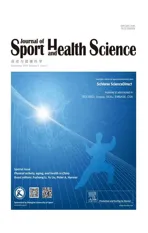Effects of age on marathon finishing time among male amateur runners in Stockholm Marathon 1979-2014
2016-10-24NiklasLehto
Niklas Lehto
Department of Health Sciences,Luleå University of Technology,Luleå S-971 87,Sweden
Effects of age on marathon finishing time among male amateur runners in Stockholm Marathon 1979-2014
Niklas Lehto
Department of Health Sciences,Luleå University of Technology,Luleå S-971 87,Sweden
Purpose:The purpose of the present study was to investigate the age-related changes in the endurance performance among male amateur marathon runners.
Methods:Subjects were taken from the 36 Stockholm Marathons held from 1979 through 2014,and age and finishing time were analyzed for a total of 312,342 male runners.
Results:The relation was found to be a second-order polynomial,t=a+bx+cx2,which models 99.7%of the variation in the average running time t as a function of age x.The model shows that the marathon performance of the average runner improves up to age 34.3±2.6 years,thereafter,the performance starts to decline.A quantification of the age’s influence on running time shows that it accounts for 4.5%of the total variance seen in the performance data.
Conclusion:These outcomes indicate that the effect of age on performance in endurance running events is clearly measurable,quantifiable,and possible to describe.At the same time the findings indicate that other factors,such as training,affect the performance more.A comparison with the elite showed peak performance at the same age,but the rates of change in performance with age,improvement as well as degradation,was found to be higher among the elite.
©2016 Production and hosting by Elsevier B.V.on behalf of Shanghai University of Sport.This is an open access article under the CC BY-NC-ND license(http://creativecommons.org/licenses/by-nc-nd/4.0/).
Aerobic exercise;Health;Non-elite;Recreational runner;Regression modeling;Running
1.Introduction
As the population ages,it becomes increasingly important to understand how individual health changes with age.The physical performance changes that occur are 1 aspect of this,so just how age affects endurance performance is an important question.In recent years,attention has been given to the effects of aging on endurance performance in runners.1-6This is important since master athletes may function as a model for successful aging.7In addition,many health benefits occur with lifelong aerobic sport.8-10
An event of special interest is the marathon.The long distance puts high physical demands on the runner and successful completion requires adequate and regular endurance training.11The marathon also requires a healthy lifestyle compatible with theeffort,andit has been shown that unfavorable habits,such as smoking,lack of physical activity,and obesity,are largely absent among marathon runners.12This makes the marathon valuable as a model,since many of the age-related changes in physiological functional capacity are connected to sedentary lifestyle and lack of training.8,12-16
Although it is obvious that the physical capacity of senior athletes and runners is reduced with age,there is much debate abouttheactualrelationshipbetweenperformanceand age.3,14,17These and other investigations have focused on the best runners to study how performance changes with age,1,2,18and some have tried to find mathematical models for the agedependent variation in performance.15,17,19-21Less attention has,however,been paid to the performance changes that occur within the whole group of marathon runners including amateur and recreational runners,which will be the focus of the current paper.
The purpose of the present study was to investigate the age-related changes of the endurance performance in a population of male marathon runners,including amateur and recreational runners.The main research question was stated as:How long does it take for a male marathon runner who is x years old to finish the Stockholm Marathon?In addition,the aim was to quantify how much of the variations in running time that can beexplained by age and to determine if an optimum age exists for running the marathon.One hypothesis was that the effect of age on performance is clearly measurable,quantifiable,and possible to describe mathematically.Since previous studies have focused on the best runners,a final aim was to compare the effect of age on the whole population of male marathon runners with the effect of age on the elite.
Peer review under responsibility of Shanghai University of Sport.
E-mail address:Niklas.Lehto@ltu.se
http://dx.doi.org/10.1016/j.jshs.2015.01.008
2095-2546/©2016 Production and hosting by Elsevier B.V.on behalf of Shanghai University of Sport.This is an open access article under the CC BY-NC-ND license(http://creativecommons.org/licenses/by-nc-nd/4.0/).
2.Methods
2.1.Subjects
The subjects in this study were taken from the 36 Stockholm Marathonsheldfrom1979through2014.Ageandrunningtimeof all male finishers were analyzed.The analysis was performed on the male finishers since there are roughly 5.3 times as many male finishers as female finishers.This is essential,as the mathematical model-building has the potential to be more reliable when more data are used.The data were obtained from the marathon website(www.stockholmmarathon.se).As in other studies involving publicly available data,the requirement of consent was waived.2,22All procedures used in the study met the ethical standards of the Swedish Ethical Review Act and were approved by the Regional Ethical Review Board in Umeå,Sweden.
The course of the Stockholm Marathon has changed somewhat over the years,but the conditions have remained quite stable from race to race.It involves 2 slightly different laps across the islands of Stockholm with a double crossing of a long bridge with a height difference of 34 m.In 1980,the arranger introduced a limit that maximized the allowed running time at 6 h.Since 1982,the Swedish champion in marathon-running has been crowned at the Stockholm Marathon,but the participants are primarily non-elite.In 1982,the event was moved to the beginning of June,having previously been held in August.
Thecollecteddatacanbeseenasasampleofepidemiologically relevant size from the population of healthy men,or as a sample from the population of potential marathon runners.The sample of subjects is not totally random as the participation is a choice of thesubject,i.e.,self-selection,andfactorsliketheattractivenessof theStockholmMarathonmightinfluenceindividualchoice.Onthe other hand,the event organizer does not have any inclusion cut-off times for registration.This means that the event is open to anyone until the participation limit has been reached.
The most common male finishers were from Sweden(64.1%),followed by Finland(15.5%),Germany(2.9%),UK(2.7%),France(1.9%),Norway(1.7%),and Denmark(1.5%),in the cohort of finishers from 2014.Less than 0.1%of the finishers were from Kenya or Ethiopia,which is similar to previous findings.23,24In total over 80 nations were represented.
Some individuals appear more than once in the complete data set,but since Stockholm Marathon is an annual event no subject appears more than once when the cohort is divided into 1-year age classes.This means that the data are not nested within subjects.
2.2.Data analyses
Data processing was performed by a commercial software package(MATLAB Release 2012b;The MathWorks Inc., Natick,MA,USA).The package is an interactive environment used by engineers and scientists for data analysis,numerical computation and visualization.As an initial analysis of the data,certain background statistics were examined.These were the participation trend over the history of the event,the changes in average age,and the age distribution of the finishers.Since the finishing time was regarded as a stochastic variable,the probability distribution of this variable was analyzed.
In order to determine a mathematical model of the agedependent running time,nonparametric regression was used,which means that the predictor variable,age,was not assumed to have a predetermined functional form,but was constructed according to the information derived from the data.The distribution of readings of finisher times was seen as a natural variation in the process of running a marathon.Age was the predictor variable of interest,therefore,other variables,such as running experience,training level,fitness,weight,height,variations in the popularity of running,and weather conditions were regarded as sources for randomness in the running time.This assumption had to be verified by checking the possibility to average out their effect.
The regression analysis,based on least squares,was made in 2 ways.The first pathway(PathA)used a 3-step process,where pretreatment was made before the regression analysis.The second pathway(Path B)used the complete dataset of observations in the regression analysis.
The first step in Path A was to divide the cohort into 1-year age classes.Within a single age class the distribution of running times is a result of other variables than age.Examples of these other variables are mentioned above.The second step was to use these distributions to calculate averages and confidence intervals per age-class.This was motivated by the fact that the average is the best estimate of the true value when the data show variations in the readings.25-27Further,it was essential to note that the standard uncertainty,which is used for confidence interval calculations,is given by
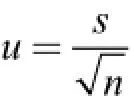
where n is the number of measurements in the set and s is the estimated standard deviation.25,26This means that the uncertainty goes down when more readings are used from a given distribution;hence,the statistics are improved when results from more runners are added to the data.This was most important in age-classes with few participants.The third step in Path A was to use the calculated averages and confidence intervals per age-class as input for the regression analysis.If it is possible to find a function of the form

where t is the average running time and x is the age of the runner,which fits the data with high level of confidence,the assumption that the other variables are suppressed from the set is correct.The coefficient of determination was used to evaluate how well the regression model can explain the effects of age on marathon finishing time.
The second pathway,Path B,skipped the initial calculation of averages in each age-class.This means that the complete dataset of observations was used,without any pretreatment,in the regression analysis to find the relation between age and running time.If the age dependence exists in the data,this regression should result in a similar mathematical model as Path A,but with a smaller coefficient of determination as it cannot explain the variation within an age class.This intra-class variation was removed in Path A,since averages per age-class were used as input for the regression analysis.A comparison of the coefficient of determination from the 2 pathways was used to evaluate how much of the total variation in running time that can be explained by age.
As a last step in the analysis a comparison was made with the elite,since the elite has been the focus of previous studies.This was made by a regression analysis using the Stockholm Marathon record running times of each 1-year age-class.The use of single record finishing times was a way to avoid an unwanted bias in the analysis.It might be unfavorable for age-classes with fewer runners,i.e.,the young and older age-classes,to use a group of top finishers to represent the elite.This kind of effect has also been seen in previous research.28
3.Results
3.1.Participation trends
Data were analyzed for a total of 312,342 male runners who completed the Stockholm Marathon from 1979 to 2014.The number of male finishers over the history of the event is shown in Fig.1.During the first years,there was a rapid increase in the number of participants,from slightly fewer than 2000 male finishers in 1979 to almost 10,000 male finishers in 1984. During the following years the number of finishers decreased,reaching a low of 6847 finishers in 1996.Since then the number of finishers has steadily increased and is now close to 12,000 male finishers per event.
In the cohort of finishers from 1979 through 2014,the average male runner has finished 2.25 races.Sixty-one point five percent have finished 1 race,15.6%2 race,7.7%3 race, 4.2%4 race,and 3.3%5 race.Zero point two percent of the male finishers have finished 25 races or more.

Fig.1.The number of male finishers per year over the history of the Stockholm Marathon.
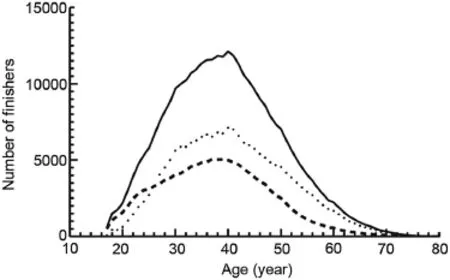
Fig.2.The number of male finishers per age-class.The solid line represents all events;the dashed line represents the first 18 years of the history of the race(1979-1996);and the dotted line represents following 18 years(1997-2014). The solid line is thus the sum of the dashed and dotted lines.
3.2.Trends in age and finishing time
Fig.2 shows the age distribution of male finishers.The number of finishers per age-class increases up to age 40,after which it falls.The age distribution has changed over the years,which can be seen from the changes in the average age,as shown in Fig.3B.During the first 4 years,the average age decreased from 37.2 in 1979 to 35.2 in 1982.Since then,the average age has been increasing,and in 2014 it was 41.5 years. The changes seen in average age,can be described by a nonlinear regression of the form


Fig.3.The trends in average finishing time(A)and average age(B)of the male finishers.The dashed lines represent least square fits.For the average age the years 1979-1981 are regarded as outliers in the fit.

Fig.4.Histogram showing the finishing times of all 40-year-old runners.The curve represents a fit of a normal distribution to the measured distribution.
The average finishing time has increased over the years,which can be seen in Fig.3A.A linear regression gives t=1.064y-1885.3,with an adjusted coefficient of determinationThis means that the average finishing time of male finishers has increased with about 1 min per year during the history of the Stockholm Marathon.
3.3.Age-related changes in performance
The analysis in order to find the age-related changes in running time was made in 2 ways.Path A started with the division of the cohort into 1-year age-classes.Fig.4 shows the distribution of finishing times of all 40-year-old runners,where a comparison with a normal distribution is also made.These distributions were used to calculate averages and confidence intervals per age-class. Fig.5 shows the resulting average running time as a function of age,with 95%confidence intervals(95%CI).The measurement data can be fitted by a second-order polynomial

with regression parameters as shown in Table 1.This regression,using the calculated average running times of each 1-year age-class of runners in the span 18-75 years,gives an adjusted coefficient of determinationWith a 95%CI,this function has its minimum at age x=34.3±2.6 years,which in turn gives a finishing time t=234.8±7.4 min.
The second pathway,Path B,skips the initial calculation of averages in each age-class.This means that all the 312,342 observations were used in the regression analysis.The resulting functional form is still a second-order polynomial.As can be seen in Table 1,the regression parameters are essentially unchanged,the CIs are somewhat narrowed,and the adjusted coefficient of determination goes down to
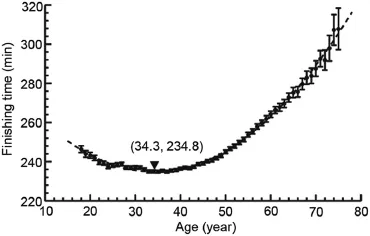
Fig.5.The average finishing time of all 312,342 male finishers as a function of age.The error bars represent 95%confidence intervals of the calculated averages. The dashed line is a least square fit of a second-order polynomial,with a minimumatagex=34.3years,whichinturngivesafinishingtimet=234.8min.
In order to compare with the elite,an analysis was made using the Stockholm Marathon record running times of each 1-year age-class(Fig.6).They show a similar second-order relation,,between age and running time,with peak performance at x=34.1 years and finishing time t=133.3 min. Regression parameters are shown in Table 1.
Since the models that describe the age-related changes in running time are second-order polynomials,the performance curveissymmetricaroundtheoptimumage.Closetotheoptimum age,the effect of the quadratic term is small.Therefore,performance improves up to the optimum age and the improvement is greatest for the youngest runners,just as the degradation in performance is greatest for the oldest runners.If the peak performance age is taken as the reference,it is possible to calculate the change in running time aswhereis the age difference from peak age.As a numerical example,the average running time increases withif the subjects are 10 years younger than or 10 years older than peak performance age,i.e.,24 years or 44 years.This increase corresponds to a change of 1.8%in running time for an offset of 10 years from optimum.This can be compared with the values found for the Stockholm Marathon elite,which gives=0.053×102=5.3 min.This,in turn,corresponds to a change of 4.0%in running time for an offset of 10 years from optimum. Thus,the elite improve and degrade at a faster rate than the average marathon runner.
Table 1 Regression parameters in the second-order polynomialfound using:I)the calculated mean finishing times of runners in the age-groups of 18-75,that is,58 observations,II)all the observed finisher times,that is,over 312,000 observations,and III)the best results in each 1-year age-class.The confidence level is at 95%.

Table 1 Regression parameters in the second-order polynomialfound using:I)the calculated mean finishing times of runners in the age-groups of 18-75,that is,58 observations,II)all the observed finisher times,that is,over 312,000 observations,and III)the best results in each 1-year age-class.The confidence level is at 95%.
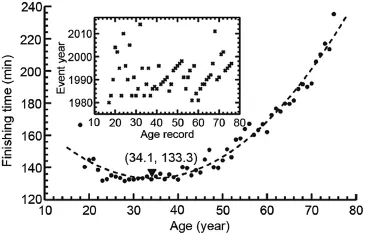
Fig.6.The single best result in every 1-year age-class.The dashed line is a least square fit of a second-order polynomial,with a minimum at age x=34.1 years,which in turn gives a finishing time t=133.3 min.The inset shows the year when the best result in every 1-year age-class was set.The nationality and number of record holders are:Sweden 33,Finland 8,Kenya 5,Ethiopia 2,Tanzania 2,USA 2,Brazil 1,Colombia 1,UK 1,Latvia 1,Lithuania 1,and Zimbabwe 1.
4.Discussion
The purpose of the present study was to find a model for the relationship between age and endurance performance in a population of male marathon runners,including amateur and recreational runners.In addition,the aim was to determine if an optimum age for running the marathon exists and to quantify how much of the total variation in running time that can be explained by age.One hypothesis was that the effect of age on performance is clearly measurable,quantifiable,and possible to describe mathematically.Finally,a comparison was made with the elite.
The main findings were:(a)an almost deterministic relation,,between average running time and age that could be modeled by a second-order polynomial;(b)the model shows that marathon performance improves up to age 34.3±2.6 years,thereafter,the performance starts to decline;(c)a quantification of the influence of age on running time shows that it accounts for 4.5%of the total variance seen in the performance data;(d)faster rates of change in performance(both improvement and degradation)for the elite than for the average marathoner. These outcomes indicate that the effect of age on performance in endurance running events is clearly measurable,quantifiable,and possible to describe with a simple mathematical model.At the same time the findings show that other factors,such as training,affect the performance more.
The present investigation uses 36 years of historical data from the same competition and increases the scope of investigation by including all finishers,amateur and recreational runners as well as the elite.The investigation treated the editions of Stockholm Marathon as different experiments to collect performance data from a large group of subjects,which made it possible to average out factors like training experience(as long as the subject can finish a marathon),weight,weather conditions,popularity trends,demography,and other things that affect running time.The procedure leaves the physiological changes due to age as the only parameter that can affect running time.The high level of confidence and coefficient of determination found in the age span from 18 to 75 years supports this. The level of confidence in model building has not been found in previous studies using fewer runners.29The current method is able to detect age-related changes in performance that have not been possible to detect without mathematical modeling on similar data.12
The current investigation indicates that there exists an age when the physiology gives peak endurance performance in the marathon.With a level of confidence at 95%,this age was found to be 34.3±2.6 years using the whole sample of male Stockholm Marathon finishers.This does not differ much from what was found using the best Stockholm Marathon results in each 1-year age-class,which suggests peak performance at age 34.1 years.This age is higher than what have been found in previous research on the elite that suggest peak performance in late 20 s.17,28,30An explanation for this difference in findings might be that they had a higher fraction of African athletes in their studies since it has been shown that they achieve the fastest race times and were younger than non-African athletes.23,24Another explanation might be that the current study uses a larger set of historical data.As can be seen from Fig.6,many of the records for the older age-classes were set before the year 2000.It might also be noted that the polynomial fit given by Lara et al.17has a peak performance at age 38,which is a higher age than the age found here.
The quadratic relationship between running time and age gives a continuous and accelerating rate of performance changes.The finding that degradation in performance starts at age~35 years is confirmed by previous research19,29,31-33and opposes that there is a breaking point in the development of performance at age 50 years.3The quadratic form indicates that there is an age-regime,before the peak,where the endurance performance improves and a regime,after the peak,where the endurance performance degrades.This can be compared with other findings that also indicate that there is a brief age-range for maximal performance,bordered by ages of lower endurance running performance.17-19,29,31-33From a physiological point of view this might be understood as a competition between agedependent improvements and degradations.Based largely on studies of highly trained male runners,the 3 main physiological determinants of endurance performance are believed to be maximal aerobic capacity,lactate threshold,and running economy.4,5,11,31,34,35This research shows that the maximal aerobic capacity is reduced with advancing age,which in turn reduces the lactate threshold.In contrast,it seems as if exercise economy has a relatively small influence on age-related decreases in exercise performance.On the other hand,high performance running is reliant on skill and precise timing in which all movements have purpose and function,which indicate that a comprehensive training background will improve the running economy.36
5.Conclusion
The present study demonstrates that it is possible to isolate and describe the effect of age on running time in a marathonusing a mathematical model.The results indicate that male marathon runners can focus their training to obtain maximal performance during their mid-30s instead of late 20s.At the same time,the finding that only 4.5%of the total variance in the performance data can be explained by age also lends support to the proposition that other factors,like life style and training parameters,have a significant effect on performance.The outcome that the rate of age-related changes in performance is smaller in the group of amateur runners than in the elite might be interpreted in 2 ways.Either the elite master runners have a potential to improve in order to slow down their degradation to a similar rate as amateur runners,or the difference reflects intrinsic physiological changes that makes elite performance difficult to maintain with age.Finally,future research should aim to extend the generalizability of the current findings by examining whether the results hold true across both genders and across different countries,and if there are long-term changes that can indicate variations over time in the health of the population.
Competing interests
The author declares no competing financial interests.
1.Jokl P,Sethi PM,Cooper AJ.Master’s performance in the NewYork City Marathon 1983-1999.Br J Sports Med 2004;38:408-12.
2.Lepers R,Cattagni T.Do older athletes reach limits in their performance during marathon running?Age 2012;34:773-81.
3.Leyk D,Erley O,Ridder D,Leurs M,Rüther T,Wunderlich M,et al. Age-related changes in marathon and half-marathon performances.Int J Sports Med 2007;28:513-7.
4.Tanaka H,Seals DR.Endurance exercise performance in masters athletes:age-associatedchangesandunderlyingphysiologicalmechanisms. J Physiol(Lond)2008;586:55-63.
5.Tanaka H,Seals DR.Invited review:dynamic exercise performance in masters athletes:insight into the effects of primary human aging on physiological functional capacity.J Appl Physiol 2003;95:2152-62.
6.Wright VJ,Perricelli BC.Age-related rates of decline in performance among elite senior athletes.Am J Sports Med 2008;36:443-50.
7.Hawkins SA,Wiswell RA,Marcell TJ.Exercise and the master athlete—a model of successful aging?J Gerontol A Biol Sci Med Sci 2003;58:1009-11.
8.Taylor AH,Cable NT,Faulkner G,Hillsdon M,Narici M,Van der Bij AK. Physical activity and older adults:a review of health benefits and the effectiveness of interventions.J Sports Sci 2004;22:703-25.
9.Trappe S,Hayes E,Galpin A,Kaminsky L,Jemiolo B,Fink W,et al.New records in aerobic power among octogenarian lifelong endurance athletes. J Appl Physiol 2013;114:3-10.
10.Szabo A,Ábrahám J.The psychological benefits of recreational running:a field study.Psychol Health Med 2013;18:251-61.
11.Sjödin B,Svedenhag J.Applied physiology of marathon running.Sports Med 1985;2:83-99.
12.Leyk D,Rüther T,Wunderlich M,Sievert A,Essfeld D,Witzki A,et al. Physical performance in middle age and old age:good news for our sedentary and aging society.Dtsch Arztebl Int 2010;107:809-16.
13.Maharam LG,Bauman PA,Kalman D,Skolnik H,Perle SM.Masters athletes.Factors affecting performance.Sports Med 1999;28:273-85.
14.Baker AB,Tang YQ,Turner MJ.Percentage decline in masters super athletetrackandfieldperformancewithaging.Exp AgingRes 2003;29:47-65.
15.Baker AB,Tang YQ.Aging performance for masters records in athletics,swimming,rowing,cycling,triathlon,and weightlifting.Exp Aging Res 2010;36:453-77.
16.Pimentel AE,Gentile CL,Tanaka H,Seals DR,Gates PE.Greater rate of decline in maximal aerobic capacity with age in endurance-trained than in sedentary men.J Appl Physiol 2003;94:2406-13.
17.Lara B,Salinero JJ,Del Coso J.The relationship between age and running time in elite marathoners is U-shaped.Age 2014;36:1003-8.
18.Knechtle B,Rüst CA,Rosemann T,Lepers R.Age-related changes in 100-km ultra-marathon running performance.Age 2012;34:1033-45.
19.Moore 2nd DH.A study of age group track and field records to relate age with running speed.Nature 1975;253:264-5.
20.Tanaka H.Age and gender interactions in physiological functional capacity:insight from swimming performance.J Appl Physiol 1997;82:846-51.
21.Fair RC.How fast do old men slow down?Rev Econ Stat 1994;76:103-18.
22.Hoffman MD,Wegelin JA.The western states 100-mile endurance run:participation and performance trends.Med Sci Sports Exerc 2009;41:2191-8.
23.Cribari M,Rust C,Rosemann T,Onywera V,Lepers R,Knechtle B. Participation and performance trends of East-African runners in Swiss Half-Marathons and marathons held between 2000 and 2010.BMC Sports Sci Med Rehabil 2013;5:24.doi:10.1186/2052-1847-5-24
24.Aschmann A,Knechtle B,Cribari M,Rüst CA,Onywera V,Rosemann T,et al.Performance and age of African and non-African runners in half and full marathons held in Switzerland,2000-2010.OpenAccess J Sports Med 2013;4:183-92.
25.Box GEP,Hunter WG,Hunter JS.Statistics for experimenters:an introduction to design,data analysis,and model building.NewYork,NY:Wiley;1978.
26.Wadsworth HM.Handbook of statistical methods for engineers and scientists.2nd ed.New York,NY:McGraw-Hill;1998.
27.BIPM,IEC,IFCC,ILAC,ISO,IUPAC,IUPAP,OIML.Evaluation of measurement data—guide to the expression of uncertainty in measurement.Jt Committee Guides Metrology 2010;104:1-20.
28.Hunter SK,Stevens AA.Sex differences in marathon running with advanced age:physiology or participation?Med Sci Sports Exerc 2013;45:148-56.
29.Slade JM,De Los Santos-Posadas H,Cress ME.Performance and characteristics of recreational master runners:a 21-year retrospective analysis.J Aging Phys Act 2003;11:190-205.
30.Hunter SK,Stevens AA,Magennis K,Skelton KW,Fauth M.Is there a sex difference in the age of elite marathon runners?Med Sci Sports Exerc 2011;43:656-64.
31.Joyner MJ.Physiological limiting factors and distance running:influence of gender and age on record performances.Exerc Sport Sci Rev 1993;21:103-33.
32.Berthelot G,Len S,Hellard P,Tafflet M,Guillaume M,Vollmer J,et al. Exponential growth combined with exponential decline explains lifetime performance evolution in individual and human species.Age 2012;34:1001-9.
33.Knechtle B,Assadi H,Lepers R,Rosemann T,Rüst CA.Relationship between age and elite marathon race time in world single age records from 5 to 93 years.BMC Sports Sci Med Rehabil 2014;6:1-7.
34.Joyner MJ.Modeling:optimal marathon performance on the basis of physiological factors.Open Access J Sports Med 1991;70:683-7.
35.Reaburn P,Dascombe B.Endurance performance in masters athletes.Eur Rev Aging Phys Act 2008;5:31-42.
36.Saunders PU,Pyne DB,Telford RD,Hawley JA.Factors affecting running economy in trained distance runners.Sports Med 2004;34:465-85.
1 December 2014;revised 12 January 2015;accepted 27 January 2015 Available online 23 May 2015
杂志排行
Journal of Sport and Health Science的其它文章
- Physical activity and health in the presence of China’s economic growth:Meeting the public health challenges of the aging population
- Physical activity and cognitive function among older adults in China:A systematic review
- Effects of Tai Ji Quan training on gait kinematics in older Chinese women with knee osteoarthritis:A randomized controlled trial
- Recruitment of older adults into randomized controlled trials:Issues and lessons learned from two community-based exercise interventions in Shanghai
- Associations between individual and environmental factors and habitual physical activity among older Chinese adults:A social-ecological perspective
- Exercise-induced rhabdomyolysis mechanisms and prevention:A literature review
